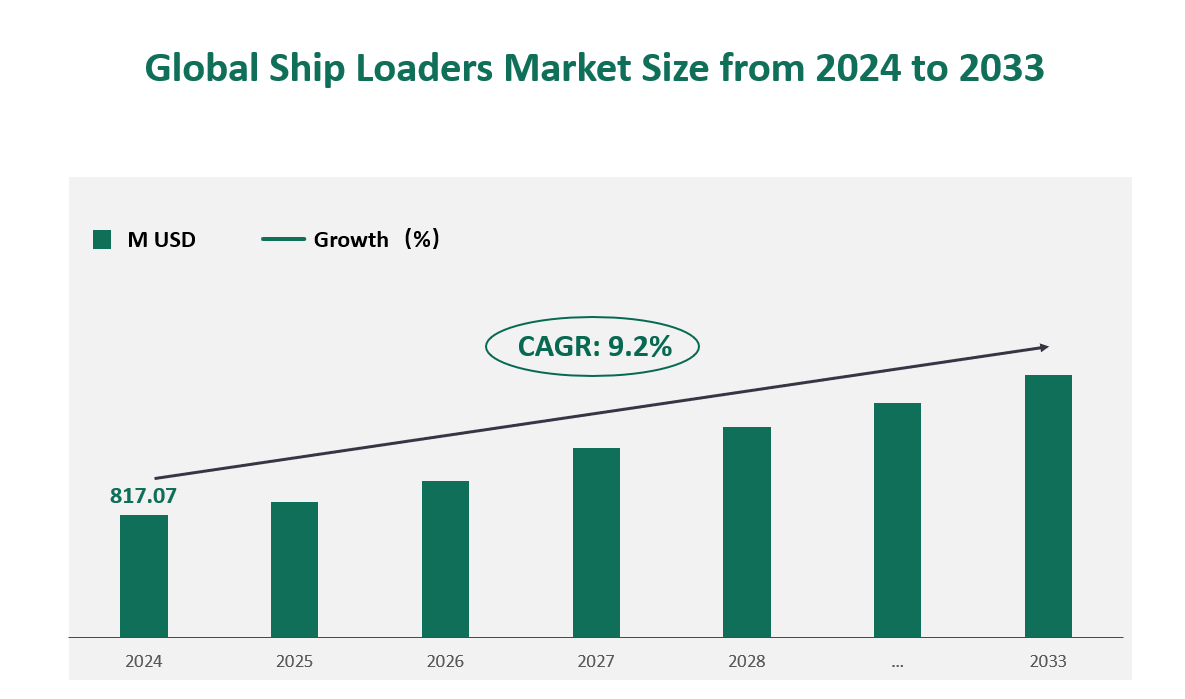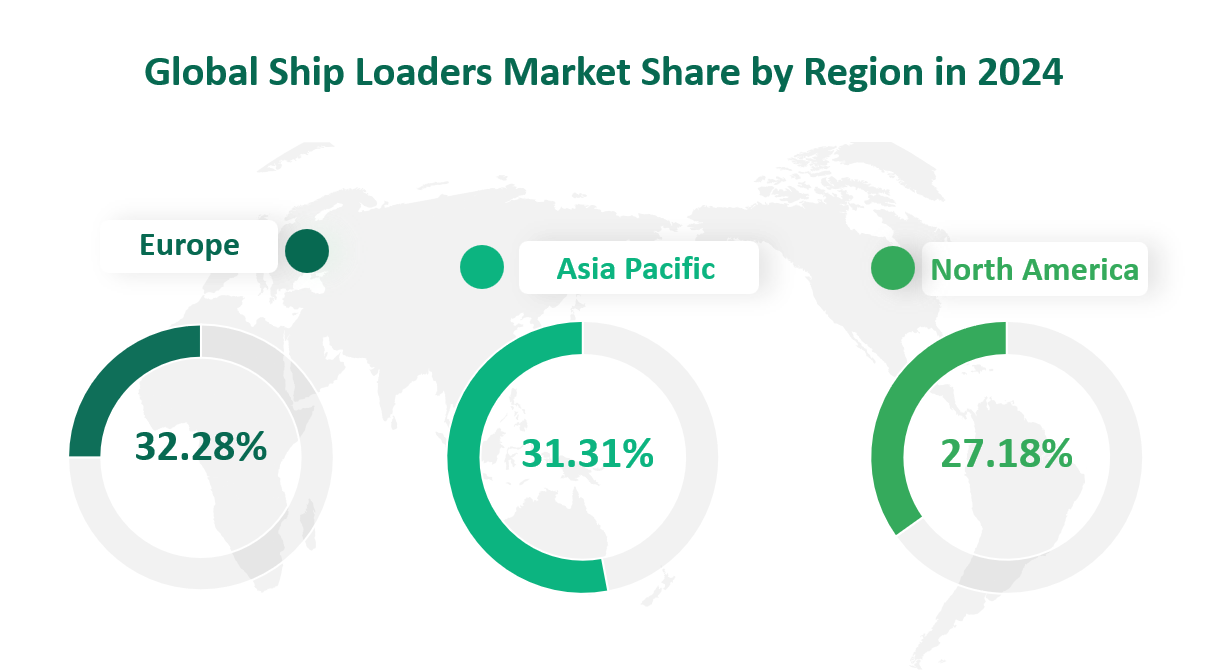1 Global Ship Loaders Market Size (Revenue) and CAGR (2024-2033)
Global Ship Loaders market generated revenue of USD 817.07 Million in 2024 with a CAGR of 9.2% during 2024 to 2033.
The Ship Loaders market in 2024 is characterized by several key trends and dynamics. Firstly, the industry is witnessing a significant shift towards larger-scale equipment, driven by the need to handle increasingly larger vessels and higher volumes of bulk materials. This trend is particularly evident in major ports and terminals that cater to global trade.
Environmental regulations are also playing a crucial role in shaping the market. Ship loaders are now being designed with advanced dust suppression and noise reduction technologies to minimize environmental impact. This shift towards eco-friendly solutions is not only driven by regulatory requirements but also by the increasing awareness of sustainability among port operators and stakeholders.
Automation is another critical trend in the Ship Loaders market. The integration of advanced control systems and robotics is enhancing operational efficiency, reducing labor costs, and improving safety standards. This trend is especially important given the harsh working conditions associated with bulk material handling.
Figure Global Ship Loaders Market Size (M USD) Outlook (2024-2033)

2 Ship Loaders Market Drivers
Table Market Drivers
Market Drivers | Description |
Growing demand | The development of global trade integration has promoted the circulation of goods on a global scale, and buyers can compare prices on a global scale. This has also promoted the demand for bulk material transportation. From the perspective of major commodities, the shipping volume of iron ore, coal, grain and other bulk cargoes is increasing rapidly. Accompanying this development is the continuous renewal of ocean-going bulk cargo ships. What follows is the construction of super large ports that can dock and unload these large ships and the demand for ship loader. At the same time, the increase in demand has also promoted the continuous development of the ship loader industry. |
Continuous development of ship loader | At present, ship loader is mainly developing towards the following trends:
The proportion of large-scale ship loader is increasing. At present, the world’s largest ore ship loader has a productivity of up to 20000t/h, which is suitable for 320,000 tons of ship type.
Environmental protection is a prerequisite for development. The development and application of effective methods such as mechanical seals, water mist pressure dust, airflow guidance or barriers, and the installation of independent dust collection systems have become one of the research topics in the design of modern ship loader. For example, the popular application of tubular belt conveyor, fully enclosed structure, and dustproof chute greatly improves the dustproof effect. In order to meet the increasingly stringent environmental protection requirements, pursue harmony with the environment, and continuously strengthen the dustproof and anticorrosive equipment, Low-noise, non-pollution and other aspects of technological development.
The difference in transported materials (such as coal, ore, cement, grain, fertilizer, etc.) makes the design of shipping equipment more and more professional, such as explosion-proof, anti-corrosion, dust-proof, and anti-pollution design requirements, and design standards are becoming more and more perfect. The manufacturer selects Stationary Ship Loaders and Mobile Ship Loaders according to actual working conditions such as materials, docks, and ship types, and proposes the best overall plan.
Due to the different characteristics of cargo loading and unloading in dry bulk terminals, and the many types of ships, as well as the impact of bulk dust, the working environment is relatively harsh, and there are strict requirements on testing equipment and technology. Therefore, the automation degree of bulk cargo loading system is low at present, and it basically relies on manual on-site operation. On the one hand, due to the harsh working conditions (high temperature, high dust, high noise, etc.) of the bulk cargo terminal, on-site manual operation will harm the physical and mental health of the on-site staff; on the other hand, due to the harsh working conditions and long time of cargo loading, it is easy to cause fatigue of workers, resulting in accidents in the process of loading. In addition, due to manual loading, the operation process will not be standardized and scientific, such as in order to avoid collision, the sluice will be suspended above the cabin, resulting in dust flying and loss of goods. As berths are the scarce resources of wharves, the loading process of bulk cargo terminals has become one of the bottlenecks restricting bulk cargo logistics, and an automated loading system is urgently needed. Therefore, one of the biggest development trends of shippers in the future is that the degree of automation will become higher and higher. |
3 Global Ship Loaders Market by Type in 2024
The global Ship Loaders market is segmented into two primary product types: Stationary Ship Loaders and Mobile Ship Loaders.
Stationary Ship Loaders
In 2024, the market value for Stationary Ship Loaders reached $446.66 million, accounting for approximately 54.67% of the total Ship Loaders market. This dominant market share is attributed to the widespread use of stationary loaders in various ports, especially those handling bulk materials like iron ore, coal, and grain.
Mobile Ship Loaders
In 2024, the market value for Mobile Ship Loaders was $370.41 million, representing 45.33% of the total Ship Loaders market. While their market share is smaller compared to stationary loaders, mobile loaders are gaining traction due to their versatility and ability to handle larger vessels.
Table Global Ship Loaders Market Size and Share by Type in 2024
Product Type | Market Size (M USD) | Market Share (%) |
|---|---|---|
Stationary Ship Loaders | 446.66 | 54.67 |
Mobile Ship Loaders | 370.41 | 45.33 |
Total | 817.07 | 100.00 |
4 Global Ship Loaders Market by Application in 2024
The Ship Loaders market is driven by various applications, each with its own unique requirements and market dynamics. The primary applications include Iron Ore, Coal, Grain, and Others (such as cement, fertilizer, and minerals).
Iron Ore
In 2024, the market value for Ship Loaders used in iron ore applications reached $157.45 million, accounting for 19.27% of the total Ship Loaders market. This significant share reflects the critical role of iron ore in global trade and the demand for specialized loading equipment.
Coal
In 2024, the market value for Ship Loaders used in coal applications was $131.66 million, representing 16.11% of the total Ship Loaders market. The demand for coal loaders is driven by the continued reliance on coal for energy production, despite increasing focus on renewable resources.
Grain
In 2024, the market value for Ship Loaders used in grain applications was $122.21 million, accounting for 14.96% of the total Ship Loaders market. The growth in grain loaders is driven by increasing global demand for food commodities and the need for efficient transportation solutions.
Table Global Ship Loaders Market Size and Share by Application in 2024
Application | Market Size (M USD) | Market Share (%) |
|---|---|---|
Iron Ore | 157.45 | 19.27 |
Coal | 131.66 | 16.11 |
Grain | 122.21 | 14.96 |
Others | 405.75 | 49.66 |
Total | 817.07 | 100.00 |
5 Global Ship Loaders Market by Region in 2024
The global Ship Loaders market in 2024 was marked by significant regional disparities in terms of market size, share, and growth dynamics. The market value reached $817.07 million, with key regions contributing differently to the overall industry performance.
North America: In 2024, North America accounted for a market value of $222.08 million, representing 27.18% of the global Ship Loaders market. The region’s market is driven by robust infrastructure investments and a focus on modernizing port facilities. The United States and Canada were the primary contributors, with the U.S. alone contributing significantly to the regional market size.
Europe: Europe held a substantial share of the global Ship Loaders market in 2024, with a market value of $263.76 million and a share of 32.28%. The region’s market is characterized by advanced technological adoption and stringent environmental regulations. Countries like Germany, the UK, and France were key players, with Germany being particularly notable for its technological advancements in ship loader design.
Asia Pacific: The Asia Pacific region emerged as the largest market by revenue in 2024, with a market value of $255.83 million and a share of 31.31%. This region’s dominance is attributed to rapid industrialization, growing trade volumes, and the construction of new port facilities in countries like China, Japan, and South Korea. China’s significant investments in port infrastructure and its role as a global trade hub were major drivers for the region’s market growth.
South America: South America’s Ship Loaders market in 2024 was valued at $50.97 million, accounting for 6.24% of the global market. Brazil and Argentina were the key contributors, with Brazil’s mining and agricultural exports driving the demand for efficient bulk material handling solutions.
Middle East and Africa: The Middle East and Africa region had a market value of $24.44 million in 2024, representing 2.99% of the global market. The region’s market growth was driven by increasing trade activities and infrastructure development in countries like the UAE and Saudi Arabia.
Table Global Ship Loaders Market Size, Region Wise in 2024
Region | Market Size (M USD) | Market Share (%) |
|---|---|---|
North America | 222.08 | 27.18 |
Europe | 263.76 | 32.28 |
Asia Pacific | 255.83 | 31.31 |
South America | 50.97 | 6.24 |
Middle East & Africa | 24.44 | 2.99 |
Total | 817.07 | 100.00 |
Figure Global Ship Loaders Market Share, Region Wise in 2024

6 Global Ship Loaders Market Top 3 Players
Company Introduction and Business Overview: Thyssenkrupp is a German multinational conglomerate with a focus on industrial engineering and steel production. Established in 1921, the company is renowned for its innovative and eco-friendly ship loaders. Thyssenkrupp operates globally, with a strong presence in Europe, Asia, and the Americas.
Products Offered: Thyssenkrupp offers a wide range of ship loaders, including stationary and mobile models. Their products are designed for high efficiency, environmental sustainability, and operational flexibility. Key features include advanced dust suppression systems, automated control mechanisms, and robust construction to handle heavy-duty applications.
Revenue in 2021: Thyssenkrupp’s revenue from the Ship Loaders segment was $40.13 million. The company’s market share and revenue growth are driven by its technological leadership and strong customer relationships in key markets.
Company Introduction and Business Overview: FLSmidth is a Danish multinational engineering company specializing in cement and mineral industries. Established in 1882, the company provides comprehensive solutions for bulk material handling, including ship loaders. FLSmidth is known for its commitment to sustainability and innovation.
Products Offered: FLSmidth offers both stationary and mobile ship loaders, designed to meet the specific needs of various industries. Their products feature advanced automation, continuous loading capabilities, and minimal environmental impact. The company’s focus on customer-specific solutions has helped it maintain a strong market position.
Revenue in 2021: FLSmidth’s revenue from the Ship Loaders segment was $41.22 million. The company’s growth is driven by its global presence and continuous investment in research and development to enhance product performance and sustainability.
Company Introduction and Business Overview: Shanghai Zhenhua Heavy Industries Company Limited (ZPMC) is a Chinese state-owned multinational engineering company. Established in 1992, ZPMC is one of the world’s largest manufacturers of cranes and large steel structures. The company has a strong presence in the global market, particularly in Asia and emerging economies.
Products Offered: ZPMC offers a wide range of ship loaders, including high-capacity models capable of handling large vessels. Their products are known for their reliability, efficiency, and cost-effectiveness. ZPMC’s focus on large-scale port infrastructure projects has helped it establish a strong market presence.
Revenue in 2021: ZPMC’s revenue from the Ship Loaders segment was $31.43 million. The company’s growth is driven by its expanding global footprint and increasing demand for large-scale port equipment in emerging markets.
Table Global Ship Loaders Revenue of Top3 Players in 2021
Company | 2021 |
Thyssenkrupp | 41.22 |
FLSmidth | 40.13 |
ZPMC | 31.43 |

